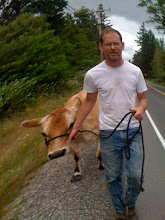 Work is progressing on the cow barn every day. The main structure is fully erected, the rafters are up and now they are starting on the skip sheathing. It is exciting to watch, but what is most interesting is not the building itself but the man who is building it. I want to share him with people.
Work is progressing on the cow barn every day. The main structure is fully erected, the rafters are up and now they are starting on the skip sheathing. It is exciting to watch, but what is most interesting is not the building itself but the man who is building it. I want to share him with people.The carpenter who designed and is building this barn is Frederic Brillant. He is a Frenchman who has lived on the Island for twenty years. Trained in France he now works on Vashon. When I asked him how he got here, his answer was: "she had red hair." You have to read that with a really heavy French accent to get the full weight of it.
I often think that I have a simple life; the calm country life that you dream of while slogging away at the office. And then I come to my senses. I write a blog, I never have my iPhone more than a foot away from me, and I read the New York Times on line daily. It is really rather difficult to resist modern life. Once you begin to take part in the the trappings of being a citizen of the 21st century, you are hooked into the whole culture.
Frederic, however, has managed to resist. I truly don't know how he does it. He has no cell phone, no computer that I have ever seen. He draws his building plans with a pencil and paper, no CAD. Most of his wood working tools he made by hand and are non-electric. I did see him out one night in a Hawaiian shirt, but I think that was an aberration.
He constructs buildings very very close to the way they were built in France three hundred years ago. He seems to live that life as well. He has a small electric stove, but I have seen him cooking more often over a wood stove at his large wood shop on the Island. If it was a schtick I would discount it entirely, but it is genuine. He sees the integrity and the beauty in the old ways and hold true to those ideals.
The result for me is an amazing barn. It is made by hand, held together with locust pegs and a few spikes on the roof rafters. It will stand far longer than myself. I have spent hours walking around it, staring at each piece, handling the posts and beams and purloins and rafters. I try to imagine this farm in a hundred years time, the modern world getting closer and closer each decade, but this barn remaining.
I wish I could take credit for this structure, but it is all Frederic's doing. He designed it and built it, my only task is to steward it through my time here at the farm.





